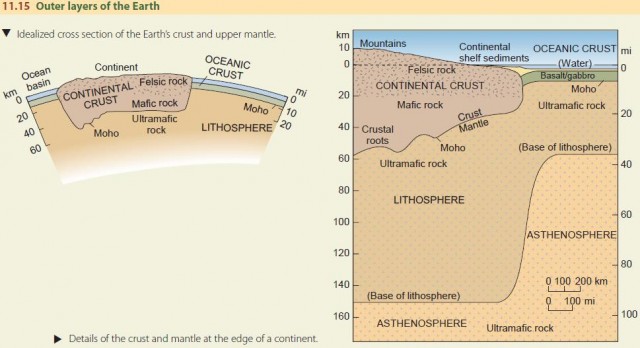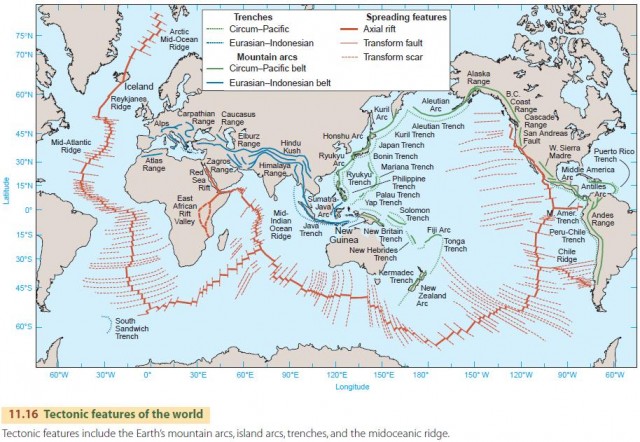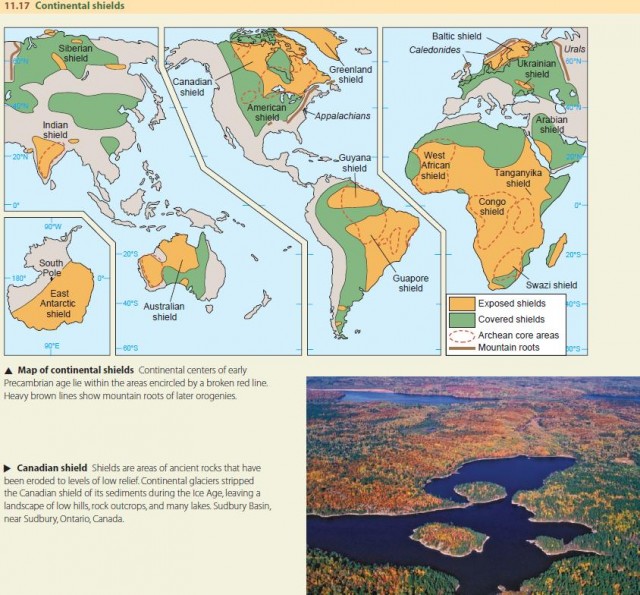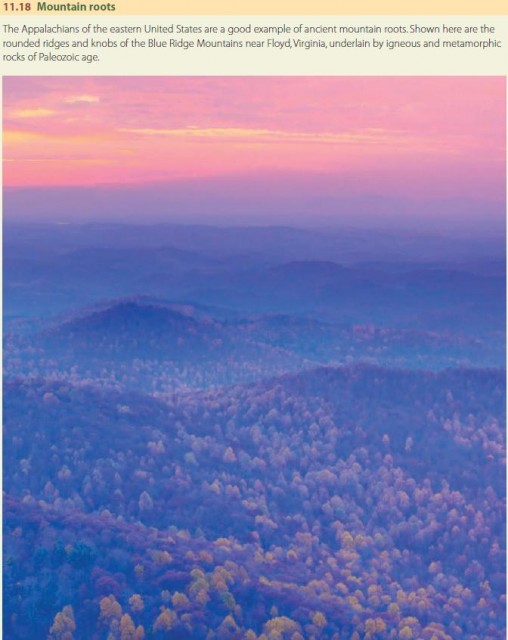Major Relief Features of the Earth’s Surface
THE LITHOSPHERE AND ASTHENOSPHERE
The major relief features of the Earth—its continents and ocean basins—were created by the movements of plates on the surface of the Earth. Geologists use the term lithosphere to describe an outer Earth shell of rigid, brittle rock, including the crust and also the cooler, upper part of the mantle (Figure 11.15). The lithosphere ranges in thickness from 60 to 150 km (40 to 95 mi). It is thickest under the continents and thinnest under the ocean basins.
Some tens of kilometers deep in the Earth, the brittle lithospheric rock gives way gradually to a plastic, or “soft,” layer named the asthenosphere. But at still greater depth in the mantle, the strength of the rock material increases again. You can think of the lithosphere on top of the asthenosphere as a hard, brittle shell resting on a soft, plastic underlayer. Because the asthenosphere is soft and plastic, the rigid lithosphere can easily move over it.

The lithospheric shell is divided into large pieces called lithospheric plates. A single plate can be as large as a continent and can move independently of the plates that surround it—like a great slab of ice floating on the polar sea. Lithospheric plates can separate from one another at one location, while elsewhere they may collide in crushing impacts that raise great ridges.
RELIEF FEATURES OF THE CONTINENTS
We divide continents into two types of region: active mountain-making belts (Figure 11.16) and inactive regions of old, stable rock. The mountain ranges in the active belts grow through one of two very different geologic processes. First is volcanism, in which massive accumulations of volcanic rock are formed by extrusion of magma. Many lofty mountain ranges consist of chains of volcanoes built of extrusive igneous rocks.

The second mountain-building process is tectonic activity—the breaking and bending of the Earth’s crust under internal Earth forces. This tectonic activity usually occurs when great lithospheric plates come together in titanic collisions, as we will see in more detail later in this chapter. Crustal masses that are raised by tectonic activity create mountains and plateaus. In some instances, volcanism and tectonic activity combine to produce a mountain range. Tectonic activity can also lower crustal masses to form depressions.
Active mountain-making belts are narrow zones that are usually found along the margins of lithospheric plates. We call these belts alpine chains because they are characterized by high, rugged mountains, such as the Alps of central Europe or the Himalayas of Asia. Even today, alpine mountain-building continues in many places. Belts of recent and active mountain-building account for only a small portion of the continental crust. The rest is much older, comparatively inactive rock. There are two types of stable structures—continental shields and mountain roots. Continental shields are regions of low-lying igneous and metamorphic rocks (Figure 11.17).

Shields may be exposed or covered by layers of sedimentary rock. The core areas of some shields are made of rock dating back to the Archean eon, 2.5 to 3.5 billion years ago. Remains of older mountain belts lie within the shields in many places.
These mountain roots are mostly formed of Paleozoic and early Mesozoic sedimentary rocks that have been intensely bent and folded, and in some locations changed into metamorphic rocks. Thousands of meters of overlying rocks have been removed from these old tectonic belts, so that only the lowermost structures remain. Roots appear as chains of long, narrow ridges, rarely rising over a thousand meters above sea level (Figure 11.18).

RELIEF FEATURES OF THE OCEAN BASINS
Oceans make up 71 percent of the Earth’s surface. Relief features of oceans are quite different from those of the continents. Much of the oceanic crust is less than 60 million years old, while the great bulk of the continental crust is of Proterozoic age—mostly over 1 billion years old. The young age of the oceanic crust is quite remarkable. We will see later that plate tectonic theory explains this age difference.
Figure 11.19 shows the important relief features of ocean basins. A midoceanic ridge of submarine hills divides the basin in about half. Precisely in the center of the ridge, at its highest point, is a narrow trenchlike feature called the axial rift. The location and form of this rift suggest that the crust is being pulled apart along the line of the rift.

Figure 11.19 shows a symmetrical ocean-floor model. This model fits the undersea topography of the North and South Atlantic oceans nicely (Figure 11.20, right), as well as the Indian, and Arctic Ocean basins.
These oceans have passive continental margins, which haven’t been subjected to strong tectonic and volcanic activity during the last 50 million years. This is because the continental and oceanic lithospheres that join at a passive continental margin are part of the same lithospheric plate and move together, away from the axial rift.
But unlike the symmetrical ocean-floor model of the North Atlantic, the margins of the Pacific Ocean Basin (Figure 11.20, left) have deep offshore oceanic trenches. We call these trenched ocean-basin edges active continental margins. Here, oceanic crust is being bent downward and forced under continental crust, creating trenches and inducing volcanic activity.
